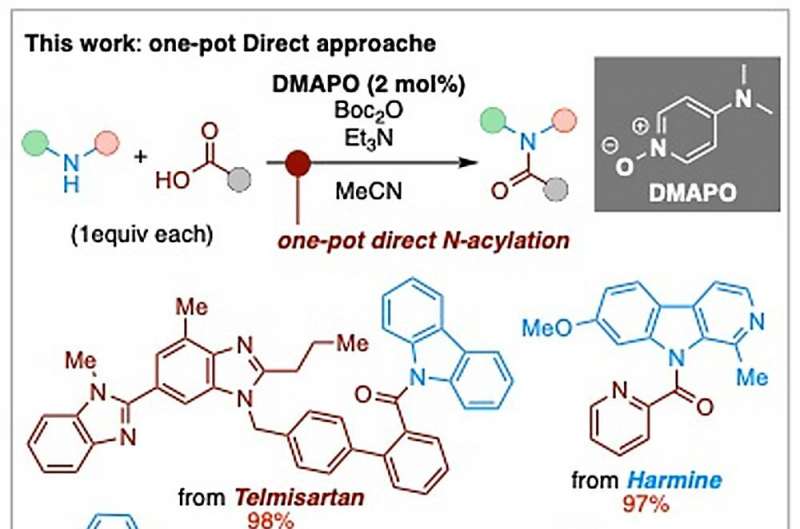This article has been reviewed according to Science X's editorial process and policies. Editors have highlighted the following attributes while ensuring the content's credibility:
fact-checked
trusted source
proofread
Optimized amide bond reaction using heterocyclic compounds and carboxylic acid

A high-yield, one-pot, scalable reaction facilitates the production of biologically relevant amide compounds using less reactive nitrogen-containing heterocyclic compounds and carboxylic acid without the use of heat or special equipment.
Amide bonds are important functional groups in medicinal chemistry and account for roughly 16% of all reactions performed in drug-discovery research. Some amide bond reactions using pharmaceutically important nitrogen-containing heterocyclic compounds, such as indole, carbazole and pyrrole, rather than amines are not efficient using conventional production methods.
In a recent study, a team of leading chemists developed a novel one-pot reaction using 4-(N,N-dimethylamino)pyridine N-oxide (DMAPO) catalyst and di-tertbutyl dicarbonate (Boc2O) to efficiently form amide bonds using low-reactivity, nitrogen-containing heterocyclic compounds and carboxylic acid without special equipment or heat.
In an effort to improve the efficiency of N-acylation, or amide bond formation, of nitrogen-containing heterocyclic compounds, or cyclic compounds composed of nitrogen and one or more other elements, a research team from Tohoku University previously reported the successful N-acylation of the heterocyclic compound indole with carboxylic acid using the Boc2O/4-(N,N-dimethylamino)pyridine (DMAP)/2,6-lutidine system. The reaction, however, required a large excess of indole for a moderate yield of the desired product.
In the current study, the research team instead used DMAPO as a catalyst and Boc2O to create a more efficient N-acylation reaction that: a) produced a high chemical yield with a 1:1 substrate ratio, b) possessed high functional group tolerance, c) allowed one-pot direct use of carboxylic acid, d) tolerated a wide variety of substrates, e) could be performed in mild and scalable conditions, and f) was simple to perform.
The team reported their results on January 13 in ChemCatChem.
"Generally, the [N-acylation] reaction is carried out by using a dehydrating condensation agent in the presence of an amine (primary amine, secondary amine or aniline), which is highly reactive with carboxylic acid. However, in reactions that use pharmaceutically important nitrogen-containing heterocyclic compounds such as indole, carbazole and pyrrole instead of amines, condensing agents do not efficiently promote the reaction," said Atsushi Umehara, lead author of the paper and assistant professor at the Graduate School of Life Sciences at Tohoku University.
"This is due to the low reactivity of nitrogen-containing heterocyclic compounds. Therefore, preactivated derivatives such as acyl chlorides and acid anhydrides derived from carboxylic acids must be used, but this method is a two-step reaction involving reagent preparation and inefficient. The use of strong metal bases is also often required, and the narrow scope of substrate application is a challenge," said Umehara.
The team recognized the utility of a more efficient N-acylation reaction for less reactive nitrogen-containing heterocyclic compounds, especially for pharmaceutical research. Their optimized, one-pot reaction produces amide compounds at high yields by reacting compounds such as indole, carbazole and pyrrole with carboxylic acid, addressing a major pain point in medicinal chemistry. "We have demonstrated the usefulness of this reaction in the synthesis of more than 120 amide compounds, achieving chemical yields of more than 85% for 104 compounds," said Umehara.
Importantly, the reaction is efficient for heterocyclic compounds that demonstrate low reactivity under conventional reaction conditions, and the yields of the team's new N-acylation reaction are high even at a 1:1 ratio of a nitrogen-containing heterocyclic compound to carboxylic acid. The new one-pot reaction conditions also eliminate the tedious cleanup steps that were necessary when strong metal bases were required for other N-acylation reaction conditions, and the new protocol requires no heat or special equipment.
Given the accessibility of these novel amide bond reaction conditions, the team predicts the DMAPO/Boc2O-mediated system will be used frequently for amide bond formation in medicinal chemistry. "We expect that the reaction developed in this research will be applied to the creation of a wide range of functional molecules in both industry and academia," said Umehara. Increasing the efficiency of these amide bond reactions will decrease the cost and time associated with amide compound development in both research and the pharmaceutical industry.
More information: Atsushi Umehara et al, DMAPO/Boc 2 O‐Mediated One‐Pot Direct N ‐Acylation of Less Nucleophilic N ‐Heterocycles with Carboxylic Acids, ChemCatChem (2023). DOI: 10.1002/cctc.202201596
Provided by Tohoku University




















